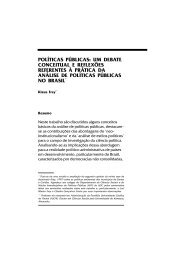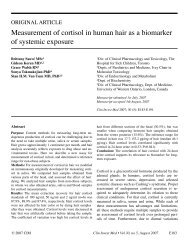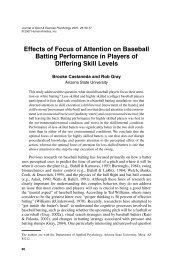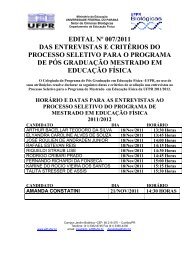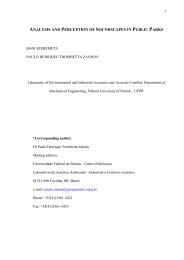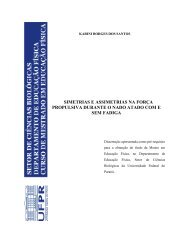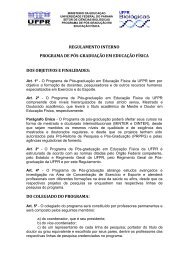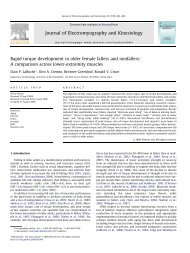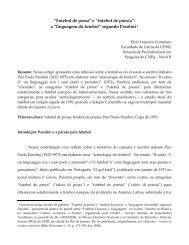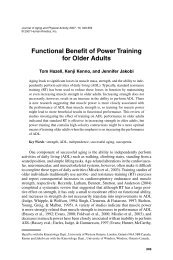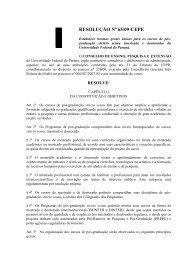Lactate threshold concepts - UFPR
Lactate threshold concepts - UFPR
Lactate threshold concepts - UFPR
You also want an ePaper? Increase the reach of your titles
YUMPU automatically turns print PDFs into web optimized ePapers that Google loves.
470 Faude et al.<br />
endurance training. Additionally, several LT approaches may be integrated<br />
in this framework. This model consists of two typical breakpoints that are<br />
passed during incremental exercise: the intensity at which bLa begin to rise<br />
above baseline levels and the highest intensity at which lactate production<br />
and elimination are in equilibrium (maximal lactate steady state [MLSS]).<br />
Within this review, LTs are considered valid performance indicators when<br />
there are strong linear correlations with (simulated) endurance performance.<br />
In addition, a close relationship between LT and MLSS indicates validity<br />
regarding the prescription of training intensities.<br />
A total of 25 different LT <strong>concepts</strong> were located. All <strong>concepts</strong> were divided<br />
into three categories. Several authors use fixed bLa during incremental<br />
exercise to assess endurance performance (category 1). Other LT <strong>concepts</strong><br />
aim at detecting the first rise in bLa above baseline levels (category 2). The<br />
third category consists of <strong>threshold</strong> <strong>concepts</strong> that aim at detecting either the<br />
MLSS or a rapid/distinct change in the inclination of the blood lactate curve<br />
(category 3).<br />
Thirty-two studies evaluated the relationship of LTs with performance in<br />
(partly simulated) endurance events. The overwhelming majority of those<br />
studies reported strong linear correlations, particularly for running events,<br />
suggesting a high percentage of common variance between LT and endurance<br />
performance. In addition, there is evidence that some LTs can estimate the<br />
MLSS. However, from a practical and statistical point of view it would be of<br />
interest to know the variability of individual differences between the<br />
respective <strong>threshold</strong> and the MLSS, which is rarely reported.<br />
Although there has been frequent and controversial debate on the LT<br />
phenomenon during the last three decades, many scientific studies have dealt<br />
with LT <strong>concepts</strong>, their value in assessing endurance performance or in prescribing<br />
exercise intensities in endurance training. The presented framework<br />
may help to clarify some aspects of the controversy and may give a rationale<br />
for performance diagnosis and training prescription in future research as well<br />
as in sports practice.<br />
1. Historical Remarks on Endurance<br />
Performance Diagnosis<br />
As early as 1808, Berzelius observed that lactic<br />
acid was produced in the muscles of hunted<br />
stags. [1] About a century later, several scientists<br />
studied the biochemistry of energy metabolism<br />
and muscle contraction in more detail. This led to<br />
a much deeper understanding of the formation of<br />
lactic acid (lactate and hydrogen ions) during intense<br />
exercise. [2-5] At that time, it was common<br />
belief that lactic acid is a waste product of glycolysis<br />
and will be formed when oxygen delivery to<br />
exercising muscles is not sufficient and muscle<br />
anaerobiosis occurs. [2,6,7] This view has been<br />
challenged considerably during the last two decades.<br />
Anaerobic glycolysis and, thus, lactate<br />
kinetics rather seem to be an ongoing process –<br />
even in the resting individual – which is highly<br />
related to the metabolic rate but not necessarily<br />
to oxygen availability (for detailed review see<br />
Gladden, [1,8] Brooks, [9] Robergs et al. [10] ).<br />
In the first half of the 20th century the concept<br />
of maximum oxygen consumption as the first and<br />
probably most common means of evaluating<br />
aerobic endurance capacity was developed by the<br />
working group of Nobel Laureate AV Hill. [6]<br />
maximal oxygen uptake (V O 2max ) has been established<br />
as a valuable tool to distinguish<br />
between fit and unfit subjects. However, several<br />
concerns were raised regarding the sensitivity of<br />
V O 2max . For instance, it is difficult to discriminate<br />
ª 2009 Adis Data Information BV. All rights reserved. Sports Med 2009; 39 (6)



